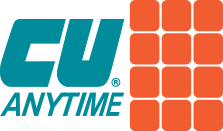Ready for contactless cards at the ATM? Here is some information to help you along…
Contactless cards offer a faster, more convenient, and more secure way to access accounts linked to your debit and credit cards. CU Anytime ATMs may accept contactless cards from any credit union which participates in the CO-OP ATM network.
What is a contactless card?
Contactless cards allow you to do transactions by tapping or holding your card over a contactless-enabled card reader.
The tap-and-go process usually takes less than a second, which is quicker than inserting or dipping your card into the card reader. It keeps your information secure and also keeps your hands off the card reader.
How can I tell if my credit card is contactless?
![]() To check whether your card is contactless, look for the contactless symbol on the front or back of your card.
To check whether your card is contactless, look for the contactless symbol on the front or back of your card.
How to use a contactless credit or debit card
 Look for the contactless symbol near the ATM card reader. The lines that appear on your card should also appear on contactless-enabled card readers.
Look for the contactless symbol near the ATM card reader. The lines that appear on your card should also appear on contactless-enabled card readers.
When prompted, enter your card PIN using the ATM keypad and start your transaction.
If your transaction is approved, the ATM will complete the transaction.
How does the contactless card work?
Contactless cards use wireless technology known as Near Field Communication (NFC). This enables the card to communicate when the card is held near the card reader during a transaction.
Contactless cards come with an EMV chip and the usual credit or debit card number, expiration date, security code and magnetic stripe. If the ATM does not have a contactless reader, you can still swipe your card.
When you hold your contactless card near the reader, it securely authenticates your card information, then sends the information to the card issuer for approval.
Contactless card security
Using the tap-and-go process can be a more convenient and secure way to conduct transactions than swiping or inserting your credit card.
Each contactless transaction creates a unique, one-time code or password—a security process known as tokenization. This helps reduce risk because the code can’t be used again—and it can be read only by the card-processing network.
